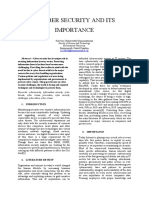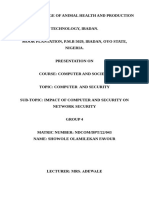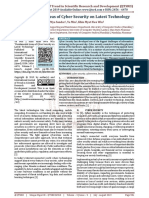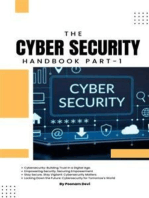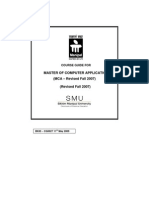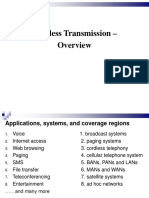Detection of Cyber Attack in Network Using Machine Learning Techniques
Uploaded by
Lionnel SarreDetection of Cyber Attack in Network Using Machine Learning Techniques
Uploaded by
Lionnel SarreISSN: 2366-1313
Detection Of Cyber-Attack in Network Using Machine Learning
Techniques
VADUPU MUKESHKUMAR, 2Dr. KPNV SATYA SREE
1
MTech student, Dept of CSE, Usha Rama College of Engineering and Technology, Telaprolu, (A.P)
Professor, Dept of CSE, Usha Rama College of Engineering and Technology, Telaprolu, (A.P)
Abstract: Cyber threats harm computer systems and networks with or without user consent.
Therefore, predicting cyber threats can be very important in these situations. We know that all
computers are connected through multiple networks, so predicting cyber threats can be very
helpful in avoiding future losses or disasters. Prediction is one of the ways we can understand
the output based on the given input. There is a strategy where the version is built on some
algorithm and that model is built with a positive data set. According to model schooling, the
model must wait for the result of a given input. These predictions are made using machine
learning algorithms. To help anticipate better impacts from a cyber threat angle. We have
explored the work done by several researchers on cyber risk predictions and can present our
own work as well. To do this, we will use special methods that allow you to achieve greater
results in predicting cyber threats. As a result, it would be very useful to have prior
information about cyber threats in addition to version usage studies. And as a result, you will
easily avoid information loss from this cyber opportunity.
Keywords: Cyber security, machine learning, malware detection, intrusion detection system,
predictions.
I. INTRODUCTION global platform to access facts and assets
with unlimited blessings. Nowadays, our
Cyberspace refers to the global
international online record and data
environment that allows trading of digital
exchange is growing tremendously with all
resources from anywhere in the world.
its disadvantages and advantages. After
Resources can be digital reports, audio,
2017, our online international became
video, images and tweets. Our online
more popular. Internet usage has increased
world consists of many components,
to 81% in developed countries and
including the Internet, technically savvy
continues to increase worldwide [1]. The
users, device resources, information, and
rise of our online world has also pushed
unskilled users. Our online global offers a
Volume VII Issue II NOVEMBER 2023 www.zkginternational.com 304
ISSN: 2366-1313
the risks of cybercrime and cyber threats financial fraud, and ransomware. This
upwards. registry covers malware detection,
intrusion detection, and spam detection.
With the increasing variety of cyber threats,
cyber security has also seen significant An email that is unwanted or unsolicited is
improvements to combat cyber crimes. called spam. Spam emails are usually used
Cybersecurity refers to a set of to spread fraudulent content or
technologies, technologists, and advertisements. The network consumes
procedures that can be used to take network and computer resources including
protective measures to protect our online bandwidth, memory, and wasted time.
world from cybercrime [2]. There are main Another cyber threat is malware. Malware,
cyber security mechanisms, namely short for malicious software, is a software
traditional cyber security and automated program that is installed on a computer to
cyber security. Traditional cybersecurity interfere with its operation and damage
has many weaknesses that contribute to digital records. Viruses, worms,
cybercrime, such as untrained users, poor ransomware, spyware, adware,
configuration of device resources, and malvertising, and Trojan horses are
limited access to simple information [3]. considered essential types of malware.
The future of cybersecurity lies in Malicious intrusion into networks and
computer cybersecurity. Advanced and computing devices is another cyber threat
automated cybersecurity techniques are to our online world. These intercepts are
particularly desirable. used to identify and test vulnerabilities in a
network or portable machine. An intrusion
They have the ability to learn from
detection device (IDS) is used to protect
experience and discover new polymorphic
against these intrusions. There are three
cyber attacks to keep pace with the
classifications of interference: fully
evolution of cybercrime.
signature/misuse-based, anomaly-based,
Cyber compromise is an act in which and hybrid.
someone will attempt to borrow data,
1.1 Cyber Threats
violate integrity standards, and harm a
computing tool or community. Cyber In the field of computer security, a
threats include phishing, malware, IoT vulnerability is a weakness in the
device attacks, denial-of-service attacks, capability that results in a harmful effect
spam, network or mobile tool intrusions, on computer systems or infrastructure.
Volume VII Issue II NOVEMBER 2023 www.zkginternational.com 305
ISSN: 2366-1313
This can be due to intentional and landscape is also evolving around all types
accidental activities. When we consider of attacks: botnets, malware, unregistered
intentional incidents, they are called malware or intrusions. A learning detection
individual attacks or criminal tool is needed to detect malicious
organizations. On the other hand, opportunities by analyzing patterns of
accidental events occur under the system behavior. In this context, we have
possibility of computer malfunction or proposed techniques to detect malicious
natural calamities such as fire, earthquake, packets and activities on a device using
typhoon, etc. According to the National device domain and deep area techniques.
Information Assurance Glossary (NIAG),
Hammouchi et. [4] proposed a STRisk
commitment is defined as any opportunity
forecasting machine in which they extend
or condition. The ability to significantly
the scope of forecasting by implementing
impact a device or infrastructure through
the dimensions of social networks. They
the disclosure of sensitive data,
analyze more than 3,800 US organizations,
unauthorized access, data modification,
including victim and non-victim
and denial of service (DoS). An essential
companies. For each company, they design
pillar of protection is the support of the
a profile consisting of a series of technical
CIA, viz. Confidentiality, integrity and
indicators and externally measured social
availability. Security is defined in these 3
elements. Additionally, to account for
pillars. When any of these pillars collapses
unreported events, they take into account
under impact, there is an additional
that the non-victim sample is noisy and
possibility of vulnerability in that
propose a noise correction method to
particular device or software program.
correct for mislabeled turnover. They then
II. REVIEW OF LITERATURE build several system domain models to
determine if the company is at risk of a
The rapid growth of Internet-connected
hacking breach. Using both technical and
devices due to the implementation of the
social capabilities, they achieve an area
Internet of Things (IoT) and Industry 4.0 is
under the curve (AUC) score of more than
a major task for cyber security threat
98%, meaning the AUC is 12% better than
detection infrastructure to detect all
what was achieved using technical
malicious applications within the network
capabilities alone. Additionally, our
and Events can be effectively attacked.
attribute significance research indicated
This is a great activity. The threat
that open ports and expired certificates are
Volume VII Issue II NOVEMBER 2023 www.zkginternational.com 306
ISSN: 2366-1313
the best technical predictors, while default rates and aggregate sales statistics,
distribution and friendliness are the best the total amount of PII and SPII, and
social predictors. sophisticated action mechanisms. Second,
the classification of personal data as
Mandal et. Al [5] Aim to consider various
sensitive and non-sensitive provides a
factors of social activities, reactions and
better value definition than previous tables.
their relatives to further expand the
Finally, all independent variables showed
category of social perception. The
multilevel factorial interactions.
proposed approach not only covers
effective response to basic social activities, Guru Akhil et. al [7] A quantitative
but also predicts and generates warnings analysis of loss event data sets related to
about situations of social importance. This 11 years (2005–2018) of digital hacking
approach has used Twitter datasets and games and security attacks was reported.
derived a fully component-based sentiment They show that, contrary to the findings in
analysis on the obtained text statistics. It the paper, hacking vulnerabilities that
has been shown to outperform newer appear in the center, search cases and
methods. penetration sizes should be represented by
stochastic cycles, not by diffusion, because
Poyraz et al. al [6] investigates various
automobile entities show to In this sense,
factors that may affect the economic
they propose unique stochastic cycle
impact of data breaches on organizations.
models to independently balance entry
This article presents a model of the total
times and catastrophe durations.
cost of a mega data breach based primarily
Furthermore, it appears that these models
on a set of records drawn from multiple
can expect between 21 appearances and
sources that categorizes the stolen
damage sizes. They perform a critical
information for US citizens as, in my
performance of subjective and quantitative
opinion, Personally Identifiable
patterns on structured data sets to gain
Information (PII) and Sensitive Personally
further insight into the progression of
Identifiable Information (SPII). They use a
piracy damage episodes. They extract a lot
rigorous stepwise regression analysis that
of data from the security bits of the
includes multilevel multinomial and real
network, and believe that the risk of digital
effects of the independent variables. There
hacking is actually reduced to the extent
are three compelling results. First, our
that you worry about it happening again,
model shows a strong relationship between
Volume VII Issue II NOVEMBER 2023 www.zkginternational.com 307
ISSN: 2366-1313
but the level of damage it causes. Not in assets, threat actors, attack patterns, tactics,
terms. methods and systems (TTP), and the
capabilities of the VERIS Community
Fang et. al [8] Initiated risk modeling and
Dataset (VCDB) for threat prediction.
prediction studies in data breaches at the
Monitors and maps these ideas with
agency level. The problem is compounded
Empirical results monitor that the use of
by the lack of violations by character
fuzzy set idea in assessing property
companies over the years, which
importance helps stakeholders to practice
disqualifies currently popular statistical
effective risk management. Additionally,
models because there aren't enough
the results test the classifier-aware tool
records to train such models. As a first step
with exemplary overall performance in
to solving the problem, they propose an
predicting unique threat types, including
advanced statistical framework to exploit
denial of service, cyber espionage, and
the dependence between different time
crimeware. Accurate risk prediction can
series. To validate the framework, they
help companies proactively select the right
apply it to a dataset of corporate-level
controls to manage risk.
breach incidents. Empirical implications
demonstrate its effectiveness in modelling III. PROPOSED SYSTEM
and predicting breach events at the
In this paper, we have provided a
enterprise level.
comprehensive review of widely used
Kure et. al [9] The objectives of effective machine learning strategies to evaluate the
cybersecurity risk management (CSRM) performance of gadget mastering strategies
are based on asset criticality, forecasting for some widely known cybercrimes. can
the types of threats, and evaluating the stumble upon. We have analyzed 3 widely
effectiveness of existing controls. Some used tools for learning strategies, namely:
strategies are followed for the proposed Selection Tree, Deep Belief Network and
unified method, including a fuzzy set Support Vector Machine. Most review
concept for asset criticality, a device study articles target only one specific risk.
classifier for random prediction, and a However, we have considered three of the
composite evaluation version for most important cyber threats. Intrusion
comparing the effectiveness of controls detection, junk mail detection and malware
( CAM). The dominant proposed method detection are considered for a look at this.
considers relevant CSRM ideas including We have provided a thorough comparison
Volume VII Issue II NOVEMBER 2023 www.zkginternational.com 308
ISSN: 2366-1313
to see the overall performance of each training is unknown. Unsupervised
classifier based on frequently used datasets. knowledge divides the data into different
We have described the computational groups based on the similarity between
complexity of each classifier. The information devices. Semi-supervised by
following step will discuss the basic gaining knowledge about the common
principles of gadget learning, a high-level features of both: supervised mastering and
approach to classifiers and evaluation unsupervised mastering. Decision tree,
criteria for evaluating classifier random forest, Navi Bays, support vector
performance. The discussion phase will device, K-nearest neighbor, deep nation
discuss cyber risks and evaluate community, artificial neural network and
performance within the validity format, K-hunt are widely used domain techniques
taking account and accuracy into account. for cyber threat detection. We have
Finally, the recovery phase will terminate considered three strategies which can be
the test. selection tree, depth perception community
and support vector device. We have briefly
IV. FUNDAMENTALS OF
explained each approach below.
MACHINE LEARNING
A deep belief network (DBN) is a
Artificial intelligence
complex representation of the underlying
Artificial intelligence is a branch of layers of a restricted Boltzmann machine
computer technology based on the (RBM). Deep concepts follow a network
simulation of the human brain by an capture method. Each layer communicates
artificial entity to automate a critical with the previous and next layer. In each
process. Machine learning is a sub-branch layer of a deep conceptual network, nodes
of AI. Achieve a specific goal by using the do not communicate late with other nodes.
effects of the experiment without explicitly In a deep concept community, each layer is
programming it. Therefore, the machine assigned input and output tasks, except for
domain no longer needs to explicitly feed the first layer and the last layer. The last
data. Device learning has three sub- layer is the classification layer. The
branches, namely supervised mastering, computational complexity of DBN is
unsupervised learning, and semi- O((n+N)OK) where k is the number of
supervised mastering. In supervised study, iterations, n represents the number of facts,
the focus is premeditated beauty/manner, and N is the range of parameters in the
while in unsupervised knowledge specific DBN.
Volume VII Issue II NOVEMBER 2023 www.zkginternational.com 309
ISSN: 2366-1313
Decision tree (DT) is a supervised system Cyber threats are increasing at an ever-
learning method. The main elements of a increasing rate. Traditional security
choice tree are nodes, paths and leaf nodes. techniques are not sufficient to deal with
A node can be a root node or an these threats. Mechanization techniques
intermediate node. The decision tree are being applied to overcome the
follows the if-then rule to find the limitations of traditional conservation
appropriate first-class root node at each systems. Automated learning strategies
level. A leaf node or terminal node is an play a role on both ends: on the defender
end node. The chosen beauty is expressed side and on the attacker side. We have
with the help of a leaf knot. The time evaluated the performance of three domain
complexity of DT is O(mn2), where n models in detecting and classifying
denotes the number of times and m intrusions, spam, and malware. We have
denotes the array of attributes.. considered frequently used and reference
data sets to estimate the accuracy and
Support vector machine (SVM) is another
precision of the evaluation results. In the
widely used supervised widget learning
previous section, we mentioned and
model. SVM performs hyperplane
concluded that we cannot recommend a
detection with the most appropriate data
specific learning method to detect every
set distribution by sorting the records on
cyber threat. Different learning models are
both sides of the hyperplane into two
being used for specific cyber threats. On
directions. Both sides of the hyperplane
the other hand, there is a wide variety of
give different glory. The beauty of each
authors who have worked to highlight the
record element depends on the side of the
limitations of machine learning techniques.
hyperplane it lands on. Support vector
We have discovered and suggest that a
systems consume a lot of space and time to
more recent reference data set may be
handle large and noisy data sets. The
necessary to confirm the current
computational complexity of SVM is O(n2)
development in the subject of study of
where n represents the time limit. A metric
cyber risk detection tools. Available data
used to evaluate the performance of a
sets lack variety and complexity of attacks
device domain classifier is called a
and lack values. Specific and customized
confusion matrix.
mastering models are required, specifically
V. CONCLUSION designed for security purposes. In the
future, we will focus on reading
Volume VII Issue II NOVEMBER 2023 www.zkginternational.com 310
ISSN: 2366-1313
incremental learning techniques for cyber Pap Risk Insur Issues Pract 45, 616–638
threat detection. (2020). ]
REFERENCES [9] Guru Akhil, C., Kumar, A.K. (2022).
“Cyber Hacking Breaches for
[1] P. R. Clearinghouse. “Privacy Rights
Demonstrating and Forecasting”.
Clearinghouse’s Chronology of Data
Breaches”. Accessed: Nov. 2017.
[2] ITR Center. “Data Breaches Increase
40 Percent in 2016, Finds New Report
From Identity Theft Resource Center and
Cyber Scout”.
[3] C. R. Center. Cybersecurity Incidents.
Accessed: Nov. 2017. [Online]. Available:
https://www.opm.gov/cybersecurity/cybers
ecurity-incidents
[4] IBM Security. Accessed: Nov. 2017.
[Online]. Available:
https://www.ibm.com/security/databreach/i
ndex.html
[5] NetDiligence. The 2016 Cyber Claims
Study. Accessed: Nov. 2017.
[6] H. Hammouchi, N. Nejjari, , "STRisk:
A SocioTechnical Approach to Assess
Hacking Breaches Risk,".
[7] Mandal, S, (2020). “Exploiting Aspect-
Classified Sentiments for Cyber Crime
Analysis and Hack Prediction” .
[8] Poyraz, O.I., Canan, M., McShane, M.
et al. “Cyber assets at risk: monetary
impact of U.S. personally identifiable
information mega data breaches”. Geneva
Volume VII Issue II NOVEMBER 2023 www.zkginternational.com 311
You might also like
- Quidway Eudemon 1000E Unified Security Gateway Command Reference (V100R002 - 03)83% (6)Quidway Eudemon 1000E Unified Security Gateway Command Reference (V100R002 - 03)946 pages
- Hyperion Planning and Budgeting - County Govts TrainingNo ratings yetHyperion Planning and Budgeting - County Govts Training44 pages
- Unit 1_01_Introduction to Cyber SecurityNo ratings yetUnit 1_01_Introduction to Cyber Security16 pages
- Mrs AshwiniShethResearchPaperonCyberSecurity-2No ratings yetMrs AshwiniShethResearchPaperonCyberSecurity-26 pages
- An Investigation On Cyber Security Threats, Taxonomy and ChallengesNo ratings yetAn Investigation On Cyber Security Threats, Taxonomy and Challenges12 pages
- What Is Cybersecurity and Why It Is ImportantNo ratings yetWhat Is Cybersecurity and Why It Is Important22 pages
- Cybersecurity_Protecting_Networks_Systems_and_DataNo ratings yetCybersecurity_Protecting_Networks_Systems_and_Data4 pages
- Current Computer Network Security Issues/Threats: Ammar Yassir Alaa A. K. IsmaeelNo ratings yetCurrent Computer Network Security Issues/Threats: Ammar Yassir Alaa A. K. Ismaeel5 pages
- Cyber Security, Tools and Methods of Cyber ThreatsNo ratings yetCyber Security, Tools and Methods of Cyber Threats6 pages
- .Cyber Attack Detection and Notifying System Using ML TechniquesNo ratings yet.Cyber Attack Detection and Notifying System Using ML Techniques7 pages
- Cybersecurity Attacks and its PreventionNo ratings yetCybersecurity Attacks and its Prevention3 pages
- Malware Detection and Analysis Challenges and ReseNo ratings yetMalware Detection and Analysis Challenges and Rese10 pages
- Technical Talk On Cyber Security TechniquesNo ratings yetTechnical Talk On Cyber Security Techniques17 pages
- Designing Security Assessment of Client Server System Using Attack Tree ModelingNo ratings yetDesigning Security Assessment of Client Server System Using Attack Tree Modeling6 pages
- Crime and Cybersecurity As Advanced Persistent Threat: A Constant E-Commerce ChallengesNo ratings yetCrime and Cybersecurity As Advanced Persistent Threat: A Constant E-Commerce Challenges8 pages
- Security Analytics: Big Data Analytics For Cybersecurity: A Review of Trends, Techniques and ToolsNo ratings yetSecurity Analytics: Big Data Analytics For Cybersecurity: A Review of Trends, Techniques and Tools6 pages
- What Is Cybersecurity-TheRealityofModernThreatsNo ratings yetWhat Is Cybersecurity-TheRealityofModernThreats5 pages
- A Survey On Cyber Security Threats and Their SolutionsNo ratings yetA Survey On Cyber Security Threats and Their Solutions8 pages
- Fundamental Areas of Cyber Security On Latest TechnologyNo ratings yetFundamental Areas of Cyber Security On Latest Technology3 pages
- Research Paper On Cyber Security: June 2021No ratings yetResearch Paper On Cyber Security: June 20217 pages
- Mrs ashwiniShethResearchPaperonCyberSecurityNo ratings yetMrs ashwiniShethResearchPaperonCyberSecurity7 pages
- Towards The Impact of Hacking On Cyber Security: IIOAB Journal May 2018No ratings yetTowards The Impact of Hacking On Cyber Security: IIOAB Journal May 201818 pages
- Leveraging On Cyber Security For Digital Economy Analysis of Emerging Cyber Security Threats and AttacksNo ratings yetLeveraging On Cyber Security For Digital Economy Analysis of Emerging Cyber Security Threats and Attacks13 pages
- Cybersecurity Protecting The Digital LandscapeNo ratings yetCybersecurity Protecting The Digital Landscape10 pages
- Machine Learning Techniques for Polymorphic Malware Analysis and IdentificationNo ratings yetMachine Learning Techniques for Polymorphic Malware Analysis and Identification8 pages
- CYBER SECURITY HANDBOOK Part-2: Lock, Stock, and Cyber: A Comprehensive Security HandbookFrom EverandCYBER SECURITY HANDBOOK Part-2: Lock, Stock, and Cyber: A Comprehensive Security HandbookNo ratings yet
- CYBER SECURITY HANDBOOK Part-1: Hacking the Hackers: Unraveling the World of CybersecurityFrom EverandCYBER SECURITY HANDBOOK Part-1: Hacking the Hackers: Unraveling the World of CybersecurityNo ratings yet
- How To Setup Iexpenses in R12: Agar Magar Se Aage Badho!No ratings yetHow To Setup Iexpenses in R12: Agar Magar Se Aage Badho!15 pages
- Fkattend User'S Manual: (Version 2.876)No ratings yetFkattend User'S Manual: (Version 2.876)66 pages
- Cisco Systems:: The Acquisition of Technology Is The Acquisition of PeopleNo ratings yetCisco Systems:: The Acquisition of Technology Is The Acquisition of People21 pages
- The Development of Quail Eggs Smart Incubator For Hatching System Based On Microcontroller and Internet of Things (Iot)No ratings yetThe Development of Quail Eggs Smart Incubator For Hatching System Based On Microcontroller and Internet of Things (Iot)6 pages
- Mengatasi Masalah Eror Saat Kita Memanggil LocalhostNo ratings yetMengatasi Masalah Eror Saat Kita Memanggil Localhost3 pages
- Best Practices For Virtual Presentations and F2F PresentationsNo ratings yetBest Practices For Virtual Presentations and F2F Presentations31 pages
- CSE 421 ID: 18101085 Transport Layer Protocols (TCP) Examination LabNo ratings yetCSE 421 ID: 18101085 Transport Layer Protocols (TCP) Examination Lab5 pages
- Network+ Guide To Networks 5 Edition: Transmission Basics and Networking MediaNo ratings yetNetwork+ Guide To Networks 5 Edition: Transmission Basics and Networking Media86 pages
- Drawing Tool App in VanillaJS With Source Code - SourceCodesterNo ratings yetDrawing Tool App in VanillaJS With Source Code - SourceCodester11 pages
- Weekly Report of Corporate Sales Team Sales Manager: Hasan A. IslamNo ratings yetWeekly Report of Corporate Sales Team Sales Manager: Hasan A. Islam5 pages
- Quidway Eudemon 1000E Unified Security Gateway Command Reference (V100R002 - 03)Quidway Eudemon 1000E Unified Security Gateway Command Reference (V100R002 - 03)
- Hyperion Planning and Budgeting - County Govts TrainingHyperion Planning and Budgeting - County Govts Training
- An Investigation On Cyber Security Threats, Taxonomy and ChallengesAn Investigation On Cyber Security Threats, Taxonomy and Challenges
- Cybersecurity_Protecting_Networks_Systems_and_DataCybersecurity_Protecting_Networks_Systems_and_Data
- Current Computer Network Security Issues/Threats: Ammar Yassir Alaa A. K. IsmaeelCurrent Computer Network Security Issues/Threats: Ammar Yassir Alaa A. K. Ismaeel
- Cyber Security, Tools and Methods of Cyber ThreatsCyber Security, Tools and Methods of Cyber Threats
- .Cyber Attack Detection and Notifying System Using ML Techniques.Cyber Attack Detection and Notifying System Using ML Techniques
- Malware Detection and Analysis Challenges and ReseMalware Detection and Analysis Challenges and Rese
- Designing Security Assessment of Client Server System Using Attack Tree ModelingDesigning Security Assessment of Client Server System Using Attack Tree Modeling
- Crime and Cybersecurity As Advanced Persistent Threat: A Constant E-Commerce ChallengesCrime and Cybersecurity As Advanced Persistent Threat: A Constant E-Commerce Challenges
- Security Analytics: Big Data Analytics For Cybersecurity: A Review of Trends, Techniques and ToolsSecurity Analytics: Big Data Analytics For Cybersecurity: A Review of Trends, Techniques and Tools
- A Survey On Cyber Security Threats and Their SolutionsA Survey On Cyber Security Threats and Their Solutions
- Fundamental Areas of Cyber Security On Latest TechnologyFundamental Areas of Cyber Security On Latest Technology
- Towards The Impact of Hacking On Cyber Security: IIOAB Journal May 2018Towards The Impact of Hacking On Cyber Security: IIOAB Journal May 2018
- Leveraging On Cyber Security For Digital Economy Analysis of Emerging Cyber Security Threats and AttacksLeveraging On Cyber Security For Digital Economy Analysis of Emerging Cyber Security Threats and Attacks
- Machine Learning Techniques for Polymorphic Malware Analysis and IdentificationMachine Learning Techniques for Polymorphic Malware Analysis and Identification
- CYBER SECURITY HANDBOOK Part-2: Lock, Stock, and Cyber: A Comprehensive Security HandbookFrom EverandCYBER SECURITY HANDBOOK Part-2: Lock, Stock, and Cyber: A Comprehensive Security Handbook
- CYBER SECURITY HANDBOOK Part-1: Hacking the Hackers: Unraveling the World of CybersecurityFrom EverandCYBER SECURITY HANDBOOK Part-1: Hacking the Hackers: Unraveling the World of Cybersecurity
- How To Setup Iexpenses in R12: Agar Magar Se Aage Badho!How To Setup Iexpenses in R12: Agar Magar Se Aage Badho!
- Cisco Systems:: The Acquisition of Technology Is The Acquisition of PeopleCisco Systems:: The Acquisition of Technology Is The Acquisition of People
- The Development of Quail Eggs Smart Incubator For Hatching System Based On Microcontroller and Internet of Things (Iot)The Development of Quail Eggs Smart Incubator For Hatching System Based On Microcontroller and Internet of Things (Iot)
- Mengatasi Masalah Eror Saat Kita Memanggil LocalhostMengatasi Masalah Eror Saat Kita Memanggil Localhost
- Best Practices For Virtual Presentations and F2F PresentationsBest Practices For Virtual Presentations and F2F Presentations
- CSE 421 ID: 18101085 Transport Layer Protocols (TCP) Examination LabCSE 421 ID: 18101085 Transport Layer Protocols (TCP) Examination Lab
- Network+ Guide To Networks 5 Edition: Transmission Basics and Networking MediaNetwork+ Guide To Networks 5 Edition: Transmission Basics and Networking Media
- Drawing Tool App in VanillaJS With Source Code - SourceCodesterDrawing Tool App in VanillaJS With Source Code - SourceCodester
- Weekly Report of Corporate Sales Team Sales Manager: Hasan A. IslamWeekly Report of Corporate Sales Team Sales Manager: Hasan A. Islam

















